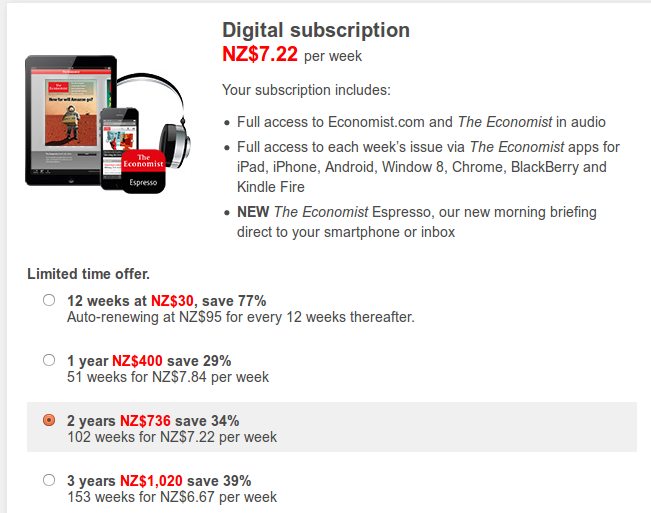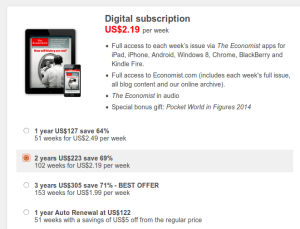 For the last few years I have subscribed to the online edition of The Economist magazine. Previously I read it via their website but for the last year or two I have used their mobile app. Both feature the full-text of each week’s magazine. Since I subscribed near 15 years ago I have paid:
For the last few years I have subscribed to the online edition of The Economist magazine. Previously I read it via their website but for the last year or two I have used their mobile app. Both feature the full-text of each week’s magazine. Since I subscribed near 15 years ago I have paid:
Launched Jun 1997 US$ 48 Jun 1999 US$ 48 Oct 2002 US$ 69 Oct 2003 US$ 69 Dec 2006 US$ 79 Oct 2009 US$ 79 Oct 2010 US$ 95 Oct 2011 US$ 95 Mar 2014 NZ$ 400 (approx US$ 300)
You will note the steady creep for a few years followed by the huge jump in 2014.
Note: I reviewed by credit card bill for 2012 and 2013 and I didn’t see any payments, it is possible I was getting it for free for two years 🙂 . Possibly this was due to the transition between using an outside card processor (Worldpay) and doing the subscriptions in-house.
Last year I paid the bill in a bit of a rush and while I was surprised at the amount I didn’t think to hard. This year however I had a closer look. What seems to have happened is that The Economist has changed their online pricing model from “cheap online product” to “discount from the printed price”. This means that instead of online subscribers paying the same everywhere they now pay slightly less than it would cost to get the printed magazine delivered to the home.
Unfortunately the New Zealand price is very high to (I assume) cover the cost of shipping a relatively small number of magazines via air all the way from the nearest printing location.
So readers in New Zealand are now charged NZ$ 736 for a two-year digital subscription while readers in the US are now charged US$ 223 ( NZ$ 293) for the same product. Thus New Zealanders pay 2.5 times as much as Americans.
Fortunately since I am a globe-trotting member of the world elite® I was able to change my subscription address to my US office and save a bunch of cash. However for a magazine that publishes the Big Mac Index comparing prices of products around the world the huge different in prices for the same digital product seems a little weird.

